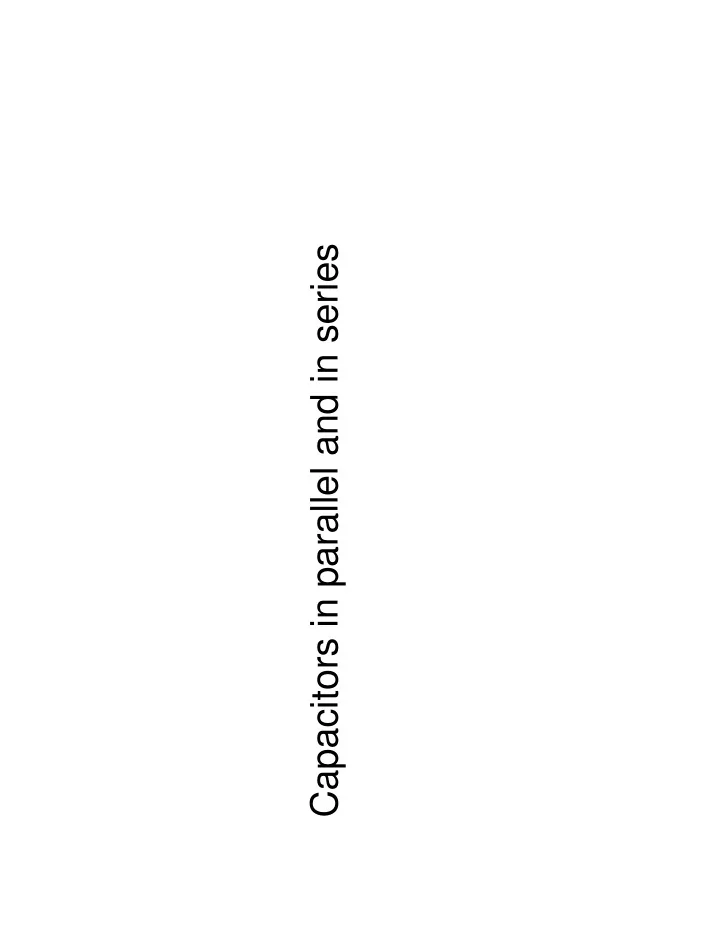

Capacitors in parallel and in series
Test 2 Next Wednesday (Oct 11) 1. Chapters 7, 8 (8.1-8.3). 2. You are not allowed to check your section number during the test. However, you will get 3 bonus points if you fill in your section number correctly. 3. 45 minutes sharp. 4. 4 multiple choices and 2 long problems. 5. Formula sheet provided. 6. Contact me before next Monday for prearrangement if you need special accommodation.
Connecting Capacitors in Parallel C C C C C 1 2 3 N C 1 Q 1 Q Q Q Q Q 1 2 3 N V V V V V V 2 1 2 3 N C 2 Q 2 1. Potential difference across V 3 = C 3 Q 3 each individual capacitor is Q C the same: (why?) V V V V V V 1 2 3 N Q Q Q Q 1 2 3 N C C C C 1 2 3 N 2. Charge stored in each Q N C N individual capacitor should be different (unless they have V N the same capacitance).
Connecting Capacitors in Series C 1 C 2 C 3 C N Q 1 Q 2 Q 3 Q N 1 1 1 1 1 C C C C C V 2 V 3 V 1 V N 1 2 3 N = Q Q Q Q Q 1 2 3 N C Q V V V V V 1 2 3 N V 2. Potential difference across 1. Charge stored in each each individual capacitor individual capacitor is the should be different (unless same: (why?) they have the same Q Q Q Q Q 1 2 3 N capacitance). CV C V C V C V C V 1 1 2 2 3 3 N N
Class 19: Electric current and resistance, Ohm’s law
Current If dQ is the amount of charge passes through A in a short time interval dt, current is defined as: dQ I dt Units of current: Ampere (A) C/s I + - - + Electrically these two cases produce the same current, but they can be distinguished with a magnetic field.
Drifting velocity v d At any instant, electrons contributing to the current is moving very fast at about 10 6 m/s. They also make collision with atoms and impurities very often, about 10 14 times per second. E As a result, electrons drift very slowly along the electric field direction with a drifting velocity v d ~ 10 ‐ 4 m/s.
Microscopic Model of Current Full of electrons How many electron will pass the area A in a short time A interval dt? Empty If n is the number of electrons per unit Full of electrons volume. Number of electrons pass through area A = n volume = n(v d dt)A A If the charge of electron is e. v d dt Charge pass through area A is Empty dQ=ne(v d dt)A dQ I I nev A d dt
Current Density and Ohm’s Law (physics version) Current density I J A Ohm’s Law (physics version) 1 J E J E or J E 1. is called conductivity. Do not confuse this with the surface charge density. 2. is called resistivity. Do not confuse this with the volumetric 1 charge density. 3. and represent the same information, . 4. and are properties of materials.
Ohm’s Law (electronics version) J I and E V Ohm’s Law: 1 I 1 V J E A V I A V I R where J E J E R A 1. R is called the resistance. 2. Units of resistance is Ohm ( ). V/A
Recommend
More recommend